Customer feedback template
What if you could interact with all your customers, engage them, ask all the questions you have, assess answers, and improve your business?
How about all the time, any time, on autopilot?
Pointerpro is the all-in-1 software that combines assessment building and distribution with personalized feedback report generation and high-end dashboarding.
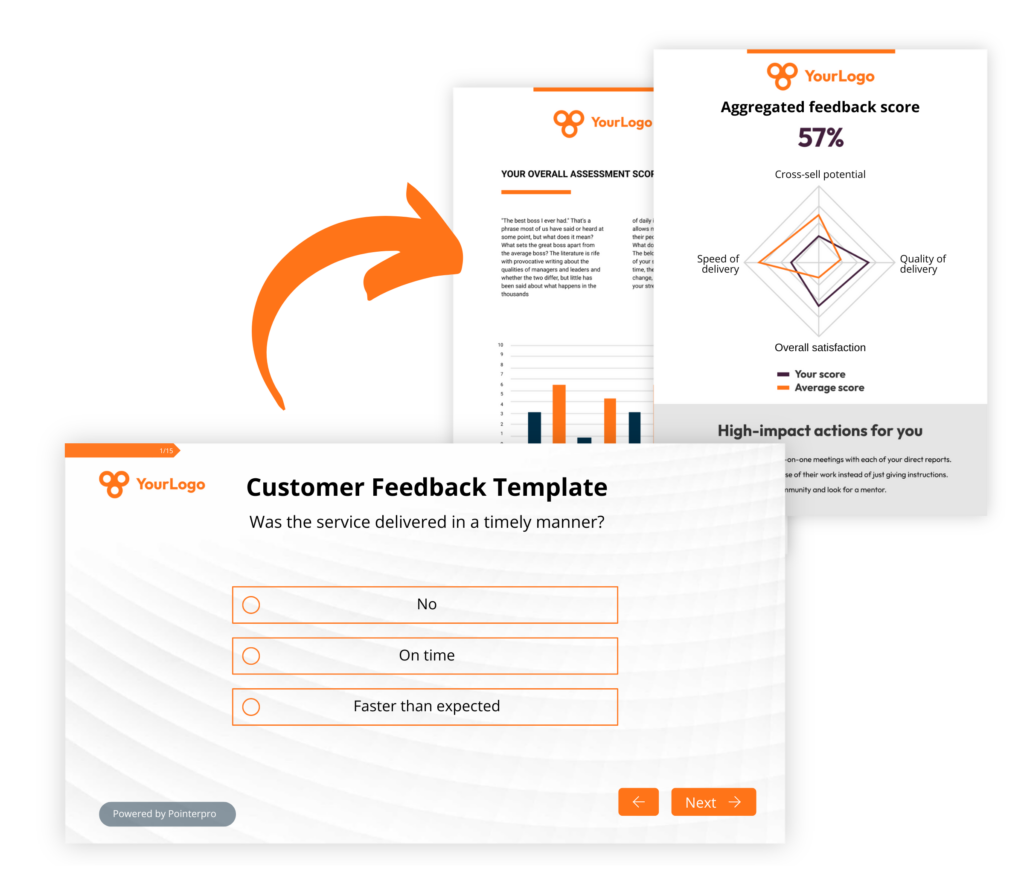
How to get customer feedback: Email vs survey template
When it comes to gathering customer feedback, well-thought survey templates are hands down the superior choice over email.
Why? Surveys are purpose-built for efficiency. They allow you to collect large volumes of responses quickly and systematically. Unlike emails, which can be time-consuming for both the sender and the recipient. Surveys offer a streamlined experience that customers appreciate. The structured format of a survey means customers can zip through questions with ease, leading to higher response rates and a more comprehensive dataset for your business.
The power of survey customer feedback templates lies in their ability to generate quantifiable, actionable data. With standardized questions, you track trends, measure satisfaction, and identify areas for improvement. This consistency is key to making informed decisions that drive your business forward.
Surveys can also offer a layer of anonymity, which encourages more honest and uninhibited feedback. Customers are more likely to share their true thoughts when they feel their responses are secure, resulting in insights that are both deep and broad.
The only advantage email may have over a generic customer feedback survey is a personal touch. And that’s exactly why you need to choose the right survey tool.
Why a generic customer feedback template isn’t enough
It’s great to ask customers to think critically about the products or services you’re providing to them. But frankly, it’s rude to just ask questions and then be on your way, without ever really interacting back.
An effective customer feedback template is one that has built in two-way-communication. And no, we’re not talking about randomly AI generated feedback. We’re talking about your feedback: Your expertise, your wisdom, and ultimately, your brand.
In the video below, Pointerpro Stacy Demes explains how that works:
3 reasons to use Pointerpro as a customer feedback tool
3 reasons to use Pointerpro as a customer feedback tool
Interactive user experience
With the Questionnaire Builder, you get to create an engaging feedback form. How? With numerous design and layout options, useful widgets, and countless question types.
Refined, score-based analysis
Our custom scoring engine helps you quantify and categorize diverse answers. The result? An objective and nuanced assessment of your customers’ feedback.
Automated feedback in PDF
Thanks to your setup in the Report Builder, respondents instantly get a detailed and personalized PDF report. Stakeholders get a complete aggregate report, when the responses are in.
1.500+ businesses worldwide build assessments with Pointerpro









Customer feedback framework
To create an effective customer feedback framework, it’s crucial to think about each step not just as a task, but as an opportunity to enhance the customer experience.
Step 1: The customer feedback request
Your initial request for feedback is more than just a call to action – it’s your chance to set the tone for the entire process.
Whether you’re sending an email invite or hosting a feedback form on your website, make sure it’s engaging and clear. If you’re dealing with a lot of customers – or maybe you want to reach end customers through your own direct customers. It may be preferable to delegate the distribution and follow-up of your requests, choose an assessment platform that offers a distribution portal. It will make things a lot easier.
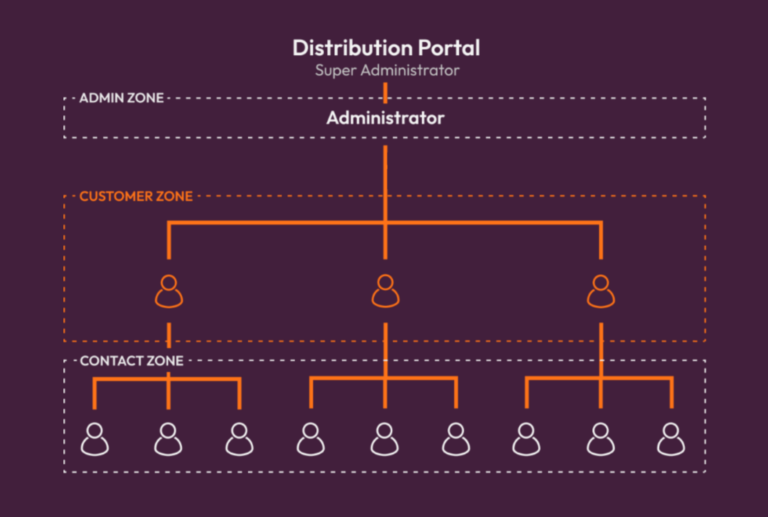
Tip: Personalize the invitation as much as possible and emphasize how their feedback directly impacts the product or service they care about. This personal touch can significantly boost response rates, making your feedback collection more robust from the start.
Step 2: The customer feedback form (or “survey”)
The feedback form itself is where the magic happens, so it’s essential to craft questions that are both insightful and easy to answer.
A key trick here is to use question logic or branching. This means the questionnaire adapts itself to the customer’s responses, only showing relevant questions based on their answers.
This not only makes the process smoother and more enjoyable for the customer, but it also ensures you’re gathering the most relevant information. Remember, a positive experience here will lead to more genuine and accurate feedback.
Step 3: The customer feedback assessment
Once you have collected the responses, the next step would be to dive into the data and weigh and evaluate the feedback. Well, actually, it isn’t. Because you should automate that process by using custom scoring methods. Our Product Director, Bruno, explains the principle in the video below.
Custom scoring allows you to segment your audience. This helps you identify patterns, preferences, and pain points across different customer groups.
Tip: Create segments based on specific criteria relevant to your business—this will allow you to tailor your future interactions and marketing strategies more effectively, turning feedback into actionable business intelligence.
Step 4: The customer feedback report
Actually, custom scoring is about more than helping you weight and interpret customer feedback. As mentioned by Bruno in the video above, it’s also what allows you to direct customized feedback to respondents.
And that feedback shouldn’t be limited to a survey result page. With a tool like Pointerpro you auto-generate a personalized feedback report for each customer, based on their responses. It’s a great way to show that you value their input, and actually circle back with useful information for them. Often, educating your audience – about your products and services but also beyond – is the key to their satisfaction.
Tip: Make sure this report is not only helpful in addressing any concerns or confusion but also branded to reflect your company’s professionalism. Include recommendations for other services or products they might like, turning a simple report into a tool for upselling and continued engagement.
The importance of continually gauging customer satisfaction
Continually gauging customer satisfaction is essential for any business that aims to stay competitive and responsive to its customers’ needs.
Customer satisfaction isn’t static. It evolves constantly based on experiences, market trends, and changes in expectations. Regularly measuring this satisfaction, means gaining real-time insights into how your customers feel about your products, services, and overall brand. A continuous feedback loop allows you to spot potential issues before they become major problems and seize opportunities before they fade away.
The things you want to measure, may differ from stakeholder to stakeholder. A product manager wants constant insight on what customers are indicating about their user experience. A customer service lead may just want to focus on how fast and how satisfactory any issues are being solved – from the point of view of the customer. A CEO may want to have a view on everything at once.
The ability to build data dashboards on the same platform you use to create and distribute customer feedback questionnaires will save you heaps of valuable time.
When feedback data is seamlessly integrated into a dashboard, you can visualize trends, track changes over time, and identify patterns at a glance. Moreover, having these capabilities on a single platform streamlines your processes, enabling you to swiftly move from data collection to strategic decision-making.
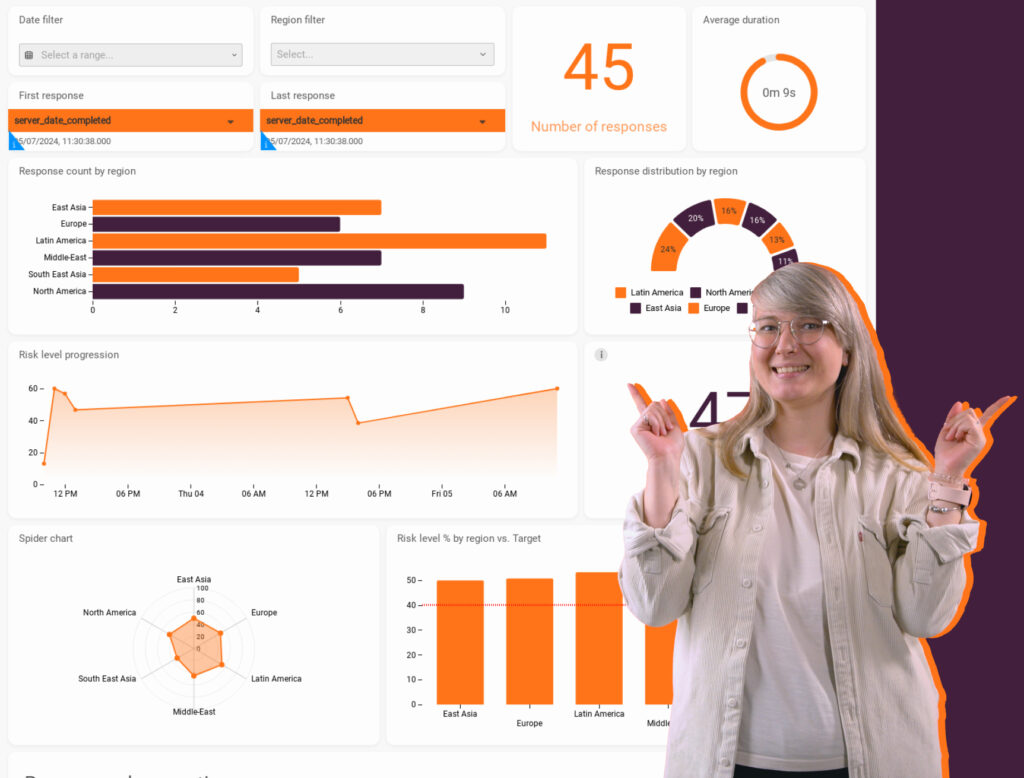
Avoid negative customer feedback to spread: Offer digital interaction
Negative customer feedback can quickly spread and damage your brand’s reputation, especially in today’s digital world where information travels fast. Offering digital interaction – like a full-fledged customer satisfaction questionnaire a proactive way to manage this.
Whatever digital channels you are using to stay in touch with customers, the key is to automate to the fullest, because today’s customers simply expect the convenience.
By providing customers with easy, accessible avenues to voice their concerns directly to you, you create opportunities to address issues before they escalate publicly.
One thing you should not lose sight of: The human touch.
How to keep the human touch in digital customer service?
Whatever digital channels you’re using, Pointerpro’s very own Customer Success specialist, Nata Deineha, urges you to focus on three pillars:
- Responsiveness
- Demonstrating empathy
- Auto-personalization
30 example questions for customer feedback
Here are 30 example questions for a customer feedback template, divided into 3 categories:
- 10 example customer feedback questions for a service business
- 10 example customer feedback questions for product success
- 10 example customer feedback questions for a restaurant business
10 example customer feedback questions for a service business
- How satisfied are you with the overall service you received?
- How would you rate the professionalism of our staff?
- Was the service delivered in a timely manner?
- How well did our service meet your expectations?
- Were your questions and concerns addressed effectively?
- How likely are you to recommend our service to others?
- Did you find our pricing to be fair and transparent?
- How would you rate the ease of scheduling or booking our service?
- Was there anything about the service that you felt could be improved?
- How likely are you to use our service again in the future?
These customer feedback template questions are designed to provide a comprehensive view of the service experience from multiple angles. Each question targets a specific aspect of the service, including overall satisfaction, staff professionalism, timeliness, and value for money. The questions range from quantitative measures (e.g., satisfaction and likelihood to recommend) to qualitative insights (e.g., open-ended questions for improvements).
By combining both Likert scale questions and open text fields, the survey captures both structured data, which is easy to analyze for trends, and detailed feedback that offers deeper insights. This dual approach ensures a balanced view of customer perceptions and areas for improvement, enabling the business to address specific issues while understanding broader satisfaction levels.
10 example customer feedback questions for product success
- How satisfied are you with the overall quality of the product?
- How well does the product meet your needs or solve your problem?
- How would you rate the product's ease of use?
- Did the product perform as you expected?
- How likely are you to recommend this product to others?
- Was the product value for money?
- How satisfied are you with the product's design and appearance?
- How well does the product compare to similar products you’ve used?
- Did you encounter any issues or problems with the product?
- How likely are you to purchase this product again in the future?
The customer feedback template questions for product success are crafted to thoroughly evaluate various facets of the product experience. The questions focus on key areas such as overall quality, usability, performance, and design. By using custom scoring, the feedback in a personalized report can be customized for each domain.
By using a mix of Likert scale questions and direct performance comparisons, the survey captures both quantifiable data and nuanced insights. This approach allows you to measure customer satisfaction with specific product attributes and understand how the product stacks up against competitors.
Including questions on value for money and likelihood to recommend further helps gauge market acceptance and customer loyalty. The combination of these question types provides a comprehensive understanding of product success and areas for improvement, enabling informed decisions for future product development and marketing strategies.
10 example customer feedback questions for a restaurant business
- How satisfied are you with the overall dining experience at our restaurant?
- How would you rate the quality of the food you were served?
- How would you describe the level of service provided by our staff?
- Was the restaurant environment clean and comfortable?
- How would you rate the speed of service during your visit?
- Did our menu offer a variety of options to choose from?
- How likely are you to recommend our restaurant to others?
- Was the pricing of the menu items fair considering the quality and quantity?
- Did you have any issues or concerns during your visit?
- How likely are you to return to our restaurant in the future?
The customer feedback template questions for a restaurant are designed to evaluate the key elements that contribute to the dining experience. In some way, it brings together the approach to questions about a product and a service.
The questions focus on things like overall satisfaction, food quality, service, ambiance, and value. By using a combination of Likert scale questions and direct inquiries about specific elements, the survey captures a comprehensive view of customer experiences.
What Pointerpro clients are saying




Customer feedback forms: When to use them (and when not)
Of course, you don’t have to stick to one employee feedback template. The advantage of an assessment platform like Pointerpro is you get to build as many questionnaires as you like. Here are a few examples of assessments that gather employee feedback, each with a different focus:
8 circumstances to push customer feedback forms
- Post-purchase or post-service: Use feedback forms immediately after a purchase or service to capture the experience while it’s still fresh. For example, after a meal at a restaurant or following a product delivery, customers are more likely to provide detailed and relevant feedback.
- After significant interactions: If a customer has had a notable interaction with your company—whether positive or negative—this is an opportune moment to request feedback. For instance, after a major customer support issue is resolved or a significant product upgrade is rolled out, gathering feedback can provide valuable insights into how these interactions were handled.
- During or after a customer journey: Implement feedback forms at various stages of the customer journey, such as after onboarding or during long-term use of a product. This helps in understanding the customer experience over time and can pinpoint specific stages where improvements might be needed.
- In-store or on-site: For physical locations, feedback forms can be placed at the point of sale or in areas where customers can easily access them, such as on tablets or kiosks. This is particularly useful for gathering immediate impressions right after an in-store experience.
- During product trials (or free samples): If you offer a free trial or sample of your product, include a feedback form as part of the experience. For example, after a customer has had a chance to use a product sample or trial version, send them a feedback form to capture their initial impressions and suggestions for improvement.
- In loyalty programs: Integrate feedback forms into your loyalty or membership programs. For instance, after a customer redeems a reward or accesses exclusive content, prompt them to provide feedback on their experience. This helps gauge the effectiveness of loyalty initiatives and the satisfaction of your most engaged customers.
- In interactive content: You can also embed feedback forms within interactive, playful content, such as quizzes on your website. For example, after completing a product recommendation quiz, ask users to rate the relevance of the suggestions and their overall experience with the quiz. This not only gathers feedback but also engages users in a fun, interactive way.
- During or right after virtual events or webinars: If you host virtual events or webinars, use feedback forms to gather impressions. This can provide valuable insights into the effectiveness of your content, presentation, and overall event experience.
Moments where using customer feedback forms may be counterproductive
- During overwhelming situations: Avoid sending feedback forms during high-stress periods, such as right after a customer has had a major issue or complaint. Instead, address their concerns first and follow up with a feedback request once the situation is resolved.
- During inappropriate times: Don’t interrupt customer experiences with feedback requests at inappropriate times, such as during a transaction or while a customer is actively engaging with your service or product. This can lead to frustration and skewed feedback.
- When there’s no clear context: Avoid sending feedback forms without a clear context or relevance. For instance, a generic feedback request with no specific reference to the recent interaction or transaction can come across as impersonal and may lead to lower response rates.
Create your customer feedback template today
You may also be interested in
Recommended reading
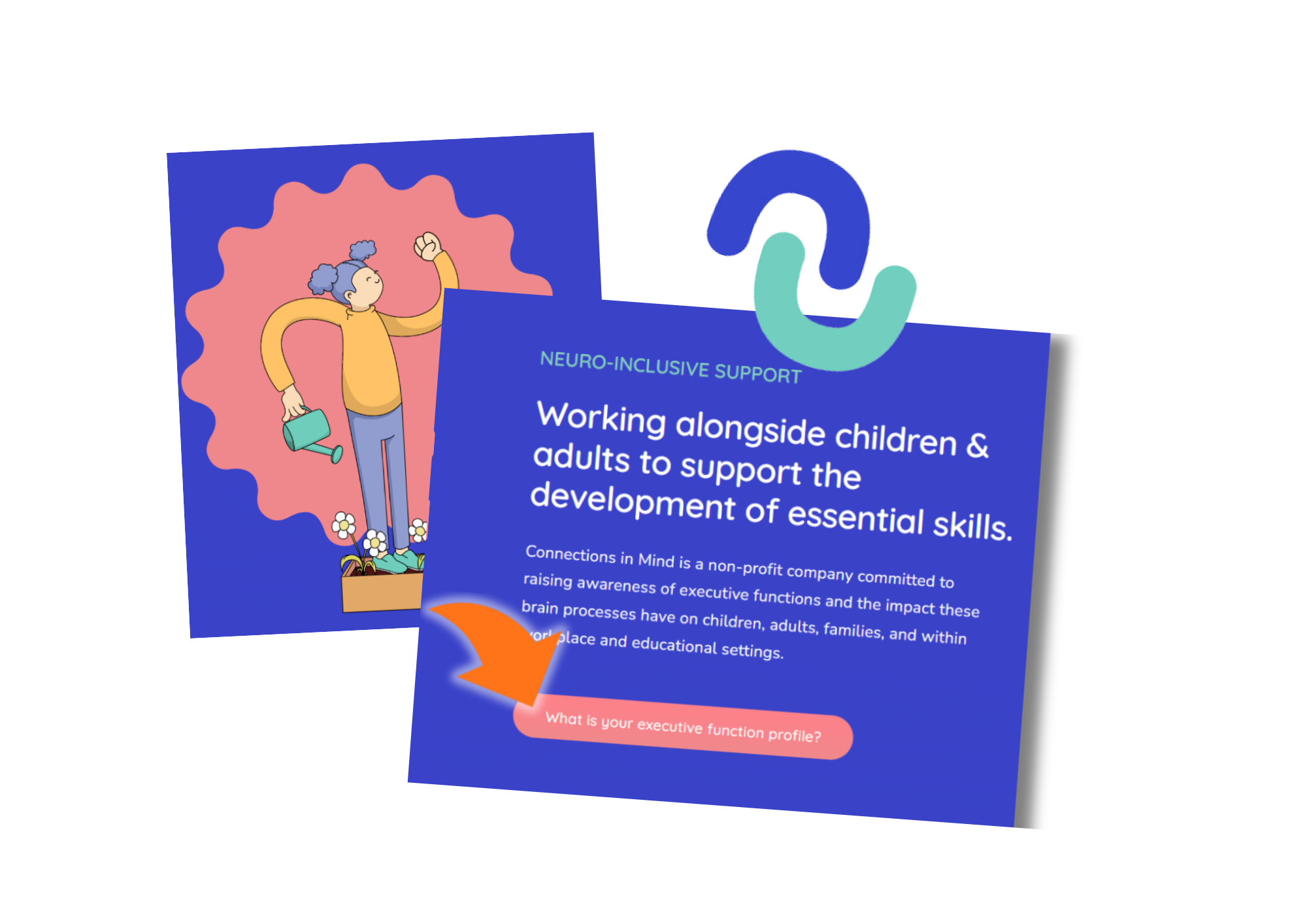
How Connections In Mind benefits the community interest through a digital mindset and a longitudinal assessment
The fact that communities benefit from diversity should not be news to anybody. One type of diversity you may not

Vlerick Business School digitalizes entrepreneurship development with Pointerpro [case study]
What do a top-tier international business school based in the capital of Europe and Pointerpro have in common? At the
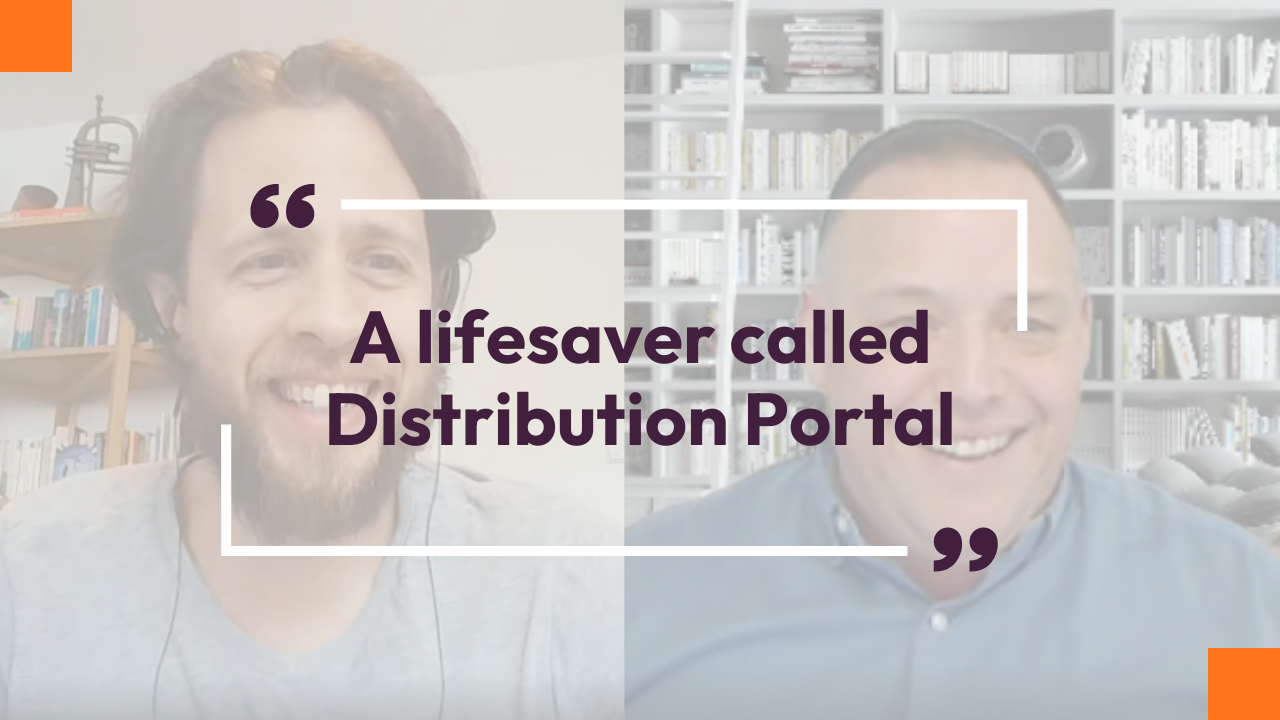
Attain Global: How to do psychometric tests right and build a cutting-edge international business [case study]
In many countries worldwide, the pursuit of skillful and engaged employees is not so much a war on talent as


